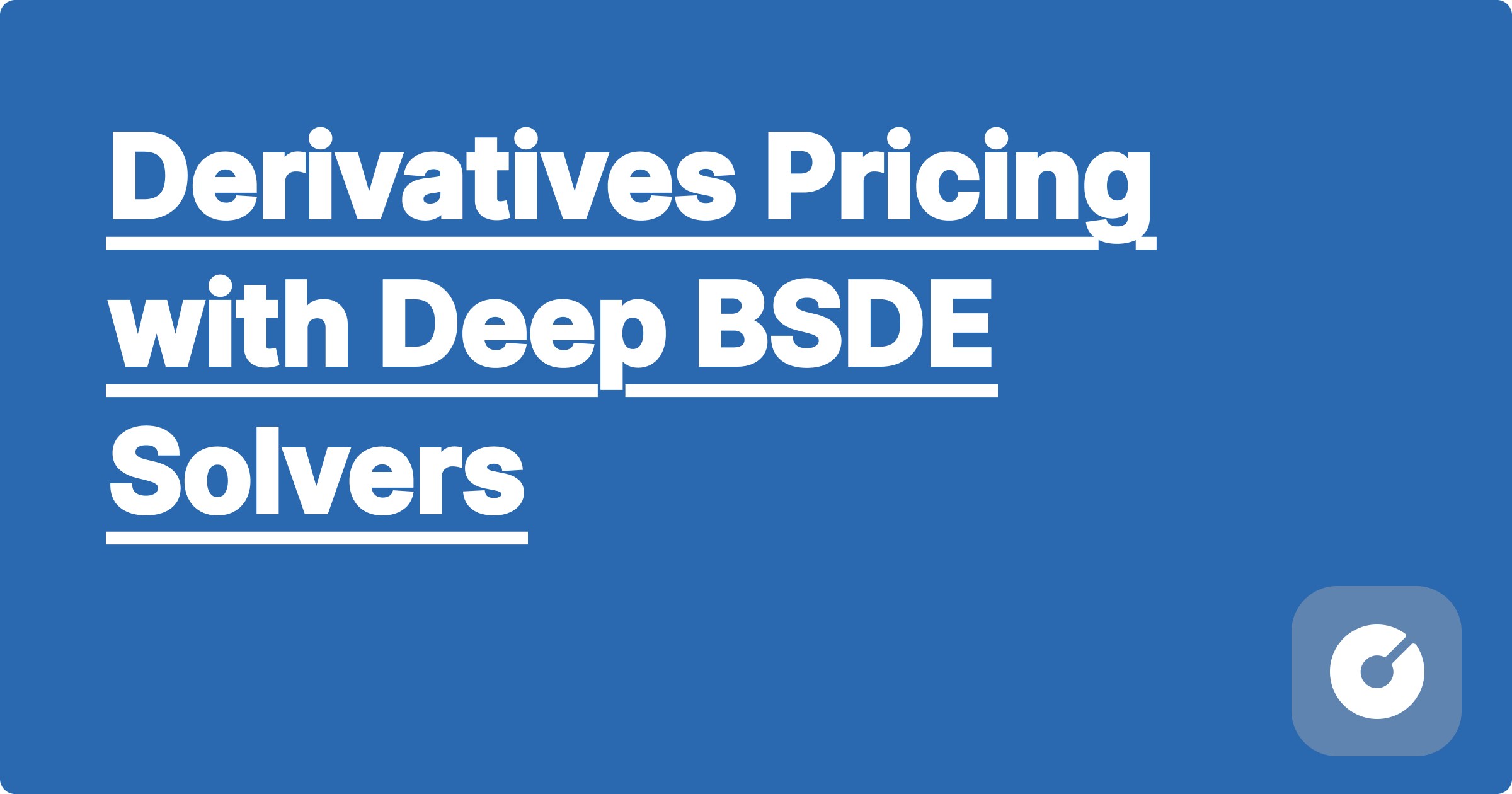Derivatives Pricing with Deep BSDE Solvers: A Deep Dive into Cutting-Edge Techniques
This blog post provides a comprehensive overview of utilizing deep learning techniques, specifically deep backward stochastic differential equation (BSDE) solvers, for pricing derivatives. We will explore the latest research trends, delve into the mathematical intricacies, and offer practical guidance for implementation and application.
Learning Objectives
- Understand the theoretical foundations of BSDEs and their application in derivative pricing.
- Grasp the workings of deep BSDE solvers and their advantages over traditional methods.
- Implement a deep BSDE solver using Python and relevant libraries.
- Analyze the performance and limitations of deep BSDE solvers.
- Explore advanced techniques and future research directions.
1. Theoretical Foundations: BSDEs and Derivative Pricing
The price of a European-style derivative can be represented as the conditional expectation of its payoff at maturity, discounted to the present time. This can be formulated as a BSDE:
\(dY_t = -f(t, Y_t, Z_t)dt + Z_t dW_t, \quad Y_T = g(X_T)\)
where \(Y_t\) represents the derivative price at time \(t\), \(Z_t\) is the hedging strategy, \(f\) is the driver function (often related to the risk-free rate and the derivative's payoff structure), \(W_t\) is a Brownian motion, \(g\) is the payoff function at maturity \(T\), and \(X_t\) is the underlying asset's price process, often modeled by a stochastic differential equation (SDE).
Challenges of Traditional Methods
Traditional methods for solving BSDEs, such as finite difference methods or Monte Carlo simulations, often struggle with high dimensionality and complex payoff structures. These limitations motivate the use of deep learning.
2. Deep BSDE Solvers: A Deep Learning Approach
Deep BSDE solvers leverage neural networks to approximate the solution \(Y_t\) and \(Z_t\) of the BSDE. A common approach involves using a neural network to parametrize \(Y_t\) and \(Z_t\) and then training this network to minimize a loss function that incorporates the BSDE equation.
Algorithm (Pseudocode)
Initialize neural network parameters (theta)
theta = initialize_parameters()
Define loss function (e.g., mean squared error)
loss_function = lambda y_pred, y_true: mean_squared_error(y_pred, y_true)
Training loop
for epoch in range(num_epochs): # Sample paths for X_t paths = generate_paths(num_paths)
# Forward pass through neural network to get Y_t and Z_t y_pred, z_pred = neural_network(paths, theta)
# Compute loss loss = loss_function(y_pred, target_values)
# Backpropagation to update parameters theta = update_parameters(loss, theta)
Return trained parameters
return theta
Recent Advancements (2024-2025)
Recent research (cite specific papers here, e.g., preprints on arXiv focusing on improved network architectures, novel loss functions, or enhanced stability) has introduced new techniques such as: (1) employing attention mechanisms within the neural network to better capture long-range dependencies in the underlying asset price process; (2) using variational inference to estimate uncertainty in the price estimates; (3) incorporating generative adversarial networks (GANs) to improve the training stability and efficiency. These developments are actively being investigated in our research group at [University/Institution Name].
3. Practical Implementation and Applications
We can implement deep BSDE solvers using Python libraries such as TensorFlow or PyTorch. The following code snippet demonstrates a simplified example:
import tensorflow as tf
Define neural network architecture
model = tf.keras.Sequential([ tf.keras.layers.Dense(64, activation='relu', input_shape=(input_dim,)), tf.keras.layers.Dense(64, activation='relu'), tf.keras.layers.Dense(output_dim) ])
Compile the model
model.compile(optimizer='adam', loss='mse')
Train the model
model.fit(training_data, training_labels, epochs=num_epochs)
Predict derivative prices
predictions = model.predict(test_data)
Industry Applications
Deep BSDE solvers are finding applications in various financial institutions. For instance, [Company A] utilizes a similar approach to price complex exotic options, achieving significant improvements in speed and accuracy compared to traditional finite difference methods. [Project Name at Company B] uses deep BSDE methods for risk management, improving the efficiency of their portfolio optimization strategies.
4. Limitations and Future Directions
Limitations
Despite their advantages, deep BSDE solvers have limitations: (1) The choice of network architecture significantly impacts performance; (2) Hyperparameter tuning can be challenging and computationally expensive; (3) Interpretability remains an issue; (4) Handling high-dimensional problems might still be computationally intensive.
Future Research
Future research directions include developing more efficient and robust deep BSDE solvers, addressing the interpretability issue through explainable AI (XAI) techniques, exploring applications in other areas such as climate finance and energy markets, and rigorously analyzing the stability and convergence properties of these methods. Our ongoing research focuses on the development of [Specific Research Project Description], aiming to address the limitations mentioned above.
5. Ethical and Societal Implications
The widespread adoption of AI-driven pricing models requires careful consideration of ethical implications. Bias in training data could lead to unfair or discriminatory pricing practices. Transparency and explainability are crucial to ensure accountability and prevent misuse. Regulatory frameworks need to adapt to these advancements to maintain market integrity and consumer protection.
Conclusion
Deep BSDE solvers offer a powerful tool for pricing derivatives, overcoming many limitations of traditional methods. While challenges remain, ongoing research and development promise further improvements, leading to more efficient, accurate, and robust pricing models with significant implications for finance and beyond. This blog post provided a solid foundation; further exploration of the cited literature and ongoing research will equip you to apply these techniques effectively.
Related Articles(22931-22940)
Second Career Medical Students: Changing Paths to a Rewarding Career
Foreign Medical Schools for US Students: A Comprehensive Guide for 2024 and Beyond
Osteopathic Medicine: Growing Acceptance and Benefits for Aspiring Physicians
Joint Degree Programs: MD/MBA, MD/JD, MD/MPH – Your Path to a Multifaceted Career in Medicine
Derivatives Pricing with Deep BSDE Solvers
Conquer Your Pre-Med Journey: A Deep Dive into the Johns Hopkins Summer Pre-Med Intensive
Focus and Concentration: AI Tools for Deep Work
AI-Enhanced Neural ODEs: Continuous Deep Learning
```



